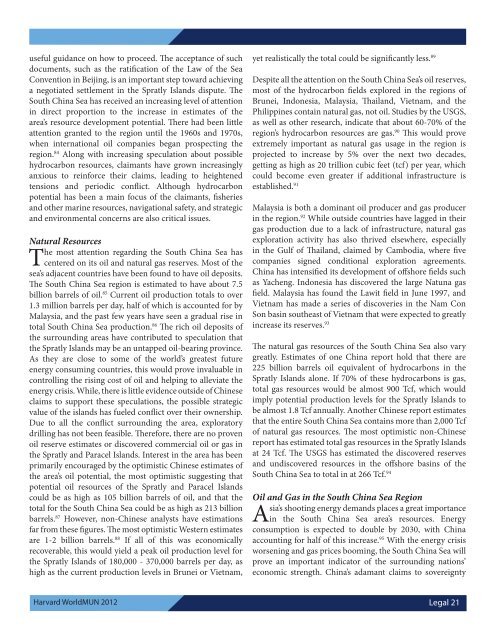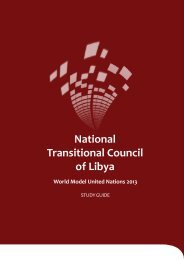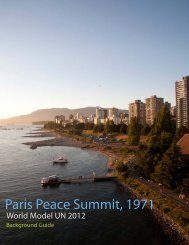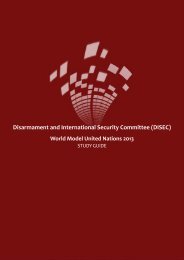Legal Committee - World Model United Nations
Legal Committee - World Model United Nations
Legal Committee - World Model United Nations
Create successful ePaper yourself
Turn your PDF publications into a flip-book with our unique Google optimized e-Paper software.
useful guidance on how to proceed. The acceptance of such<br />
documents, such as the ratification of the Law of the Sea<br />
Convention in Beijing, is an important step toward achieving<br />
a negotiated settlement in the Spratly Islands dispute. The<br />
South China Sea has received an increasing level of attention<br />
in direct proportion to the increase in estimates of the<br />
area’s resource development potential. There had been little<br />
attention granted to the region until the 1960s and 1970s,<br />
when international oil companies began prospecting the<br />
region. 84 Along with increasing speculation about possible<br />
hydrocarbon resources, claimants have grown increasingly<br />
anxious to reinforce their claims, leading to heightened<br />
tensions and periodic conflict. Although hydrocarbon<br />
potential has been a main focus of the claimants, fisheries<br />
and other marine resources, navigational safety, and strategic<br />
and environmental concerns are also critical issues.<br />
Natural Resources<br />
The most attention regarding the South China Sea has<br />
centered on its oil and natural gas reserves. Most of the<br />
sea’s adjacent countries have been found to have oil deposits.<br />
The South China Sea region is estimated to have about 7.5<br />
billion barrels of oil. 85 Current oil production totals to over<br />
1.3 million barrels per day, half of which is accounted for by<br />
Malaysia, and the past few years have seen a gradual rise in<br />
total South China Sea production. 86 The rich oil deposits of<br />
the surrounding areas have contributed to speculation that<br />
the Spratly Islands may be an untapped oil-bearing province.<br />
As they are close to some of the world’s greatest future<br />
energy consuming countries, this would prove invaluable in<br />
controlling the rising cost of oil and helping to alleviate the<br />
energy crisis. While, there is little evidence outside of Chinese<br />
claims to support these speculations, the possible strategic<br />
value of the islands has fueled conflict over their ownership.<br />
Due to all the conflict surrounding the area, exploratory<br />
drilling has not been feasible. Therefore, there are no proven<br />
oil reserve estimates or discovered commercial oil or gas in<br />
the Spratly and Paracel Islands. Interest in the area has been<br />
primarily encouraged by the optimistic Chinese estimates of<br />
the area’s oil potential, the most optimistic suggesting that<br />
potential oil resources of the Spratly and Paracel Islands<br />
could be as high as 105 billion barrels of oil, and that the<br />
total for the South China Sea could be as high as 213 billion<br />
barrels. 87 However, non-Chinese analysts have estimations<br />
far from these figures. The most optimistic Western estimates<br />
are 1-2 billion barrels. 88 If all of this was economically<br />
recoverable, this would yield a peak oil production level for<br />
the Spratly Islands of 180,000 - 370,000 barrels per day, as<br />
high as the current production levels in Brunei or Vietnam,<br />
yet realistically the total could be significantly less. 89<br />
Despite all the attention on the South China Sea’s oil reserves,<br />
most of the hydrocarbon fields explored in the regions of<br />
Brunei, Indonesia, Malaysia, Thailand, Vietnam, and the<br />
Philippines contain natural gas, not oil. Studies by the USGS,<br />
as well as other research, indicate that about 60-70% of the<br />
region’s hydrocarbon resources are gas. 90 This would prove<br />
extremely important as natural gas usage in the region is<br />
projected to increase by 5% over the next two decades,<br />
getting as high as 20 trillion cubic feet (tcf) per year, which<br />
could become even greater if additional infrastructure is<br />
established. 91<br />
Malaysia is both a dominant oil producer and gas producer<br />
in the region. 92 While outside countries have lagged in their<br />
gas production due to a lack of infrastructure, natural gas<br />
exploration activity has also thrived elsewhere, especially<br />
in the Gulf of Thailand, claimed by Cambodia, where five<br />
companies signed conditional exploration agreements.<br />
China has intensified its development of offshore fields such<br />
as Yacheng. Indonesia has discovered the large Natuna gas<br />
field. Malaysia has found the Lawit field in June 1997, and<br />
Vietnam has made a series of discoveries in the Nam Con<br />
Son basin southeast of Vietnam that were expected to greatly<br />
increase its reserves. 93<br />
The natural gas resources of the South China Sea also vary<br />
greatly. Estimates of one China report hold that there are<br />
225 billion barrels oil equivalent of hydrocarbons in the<br />
Spratly Islands alone. If 70% of these hydrocarbons is gas,<br />
total gas resources would be almost 900 Tcf, which would<br />
imply potential production levels for the Spratly Islands to<br />
be almost 1.8 Tcf annually. Another Chinese report estimates<br />
that the entire South China Sea contains more than 2,000 Tcf<br />
of natural gas resources. The most optimistic non-Chinese<br />
report has estimated total gas resources in the Spratly Islands<br />
at 24 Tcf. The USGS has estimated the discovered reserves<br />
and undiscovered resources in the offshore basins of the<br />
South China Sea to total in at 266 Tcf. 94<br />
Oil and Gas in the South China Sea Region<br />
Asia’s shooting energy demands places a great importance<br />
in the South China Sea area’s resources. Energy<br />
consumption is expected to double by 2030, with China<br />
accounting for half of this increase. 95 With the energy crisis<br />
worsening and gas prices booming, the South China Sea will<br />
prove an important indicator of the surrounding nations’<br />
economic strength. China’s adamant claims to sovereignty<br />
Harvard <strong>World</strong>MUN 2012 <strong>Legal</strong> 21

















